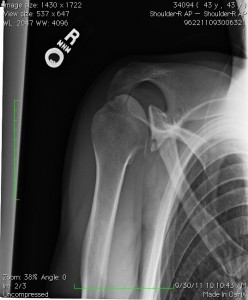 “Well now I’ve done it,” I grimaced as I crashed to the ground, my daughter cradled in my left arm and my right arm hanging limply at my side, below a very dislocated shoulder.
“Well now I’ve done it,” I grimaced as I crashed to the ground, my daughter cradled in my left arm and my right arm hanging limply at my side, below a very dislocated shoulder.
I’d been trying to get myself and her to the top of an inflatable slide at the pool, thinking it would be great fun to shoot down together into the water. Trouble was, I didn’t have the traction to get up the ladder with her in one arm. Presto! there was a rope next to the ladder. I grabbed it, not thinking very clearly as to what might happen if we slipped. Ouch.
I had the great fortune, though, to be discovered by an orthopedist who was also at the pool, trying to enjoy the afternoon with his family (until I interrupted things). He kindly relocated my shoulder using the aptly-named traction-countertraction method (just watch the video). Or if you’re easily made queasy, picture a game of tug o’ war — with your arm as the rope.
Shoulder dislocations represent 50 percent of all major joint dislocations, mainly because the shoulder is such an inherently unstable joint. Translation: the “cup” in which the ball of the humerus (arm bone) sits is quite shallow (picture a golf ball on a tee). That’s a far different design than, say, the hip joint, which is buried deep within its cup in the pelvis. As a result, the shoulder is much more mobile than the hip. But freedom always comes at a price.
Following dislocation, I was splinted. (But not before I dislocated it again in the pool, just to illustrate how foolish some patients can be.) X-rays showed I had a somewhat unusual fracture called a bankart lesion, where a little piece of bone breaks off the cup (also known as the glenoid). The larger the fracture, the less of the cup remains intact, and the more likely the shoulder will be pathologically unstable (recurrent dislocation). Again, picture trying to balance that golf ball on a tee that is missing a big chunk — the darn ball keeps falling off.
Need a visual aid? Take a look at my x-ray. The drumstick-shaped humerus is resting next to what looks like a golf tee on its side. Now look and see if you can find where the “tee” is broken. (Email me with your answer — the first 10 correct respondents get a Baskin Clinic pedometer).
With a condition as common as shoulder dislocation, you would think we’d have good data to guide treatment decisions. Alas (as with many other medical diagnoses), the existing research does not always answer the question you are asking.
My orthopedist astutely (if not sensitively) pointed out one thing I had going in my favor: “You’re old.” Older folks have less stretchy collagen fibers, thereby tending to produce stiffer scars when they heal. This helps hold the shoulder in place and makes future dislocation less likely.
But beyond that, I had few reference points — starting with the basics, like the recommended period and position of immobilization. I found studies looking at everything from one week to three weeks of slinging, in positions ranging from internal rotation (forearm resting on the abdomen) to external rotation (forearm out to the side). Bottom line: no clear consensus.
Then there was the whole question of repair versus watchful waiting. It reminded me a great deal of my early (and largely unsuccessful) attempts at dating — do you call her and ask for that second outing, or wait and play a little coy? Both romantic courtship and shoulder therapy have a long way to go in terms of evidence-based research.
I wanted the answer to the question: “For someone my age, how do results differ between treatment (surgery) and no treatment (physical therapy alone)?” What I mostly found was the equivalent of scientific hairsplitting: comparing one surgical technique to another, or one fixation device to another. It’s like going out to breakfast and being offered only variations on sausage and bacon, when you really want to take a look at the pancakes and waffles, too.
I found one article on conservative treatment (written in German) for my type of injury. The study involved only 14 individuals with large fractures like mine. Regardless, the authors reported very positive results: no subsequent dislocations and no development of arthritis over an average of five years. So my surgeon and I crossed our fingers and decided to forgo surgery.
So far I think we have made the right wager. Going in, I was reassured by one statement my surgeon made: “It’s what I would do if it were my shoulder.”
Welcome to the art of medicine.
